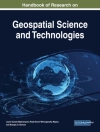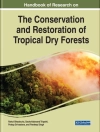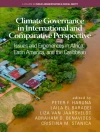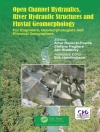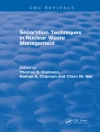This book comprises the select proceedings of the International Conference on Water, Environment, Energy and Society. The book is divided into four parts. Part I deals with some aspects of climatic characteristics ranging from changes in temperature and sunshine hours to downscaling to global climate patterns and effects of El Niño-Southern Oscillation (ENSO) and Indian Ocean Dipole (IOD) on extreme rainfall. Part II covers rainfall analysis, including changes in regional rainfall series, analysis of non-stationarity, summer monsoon and rainfall scenarios. Impacts of climate change are treated in Part III. Change point analysis, greenhouse gas emissions, rainfall variability, water resources variability, and water resources sustainability are discussed in this part. The concluding Part IV is on low flow and drought. It deals with the Standardized Precipitation Index (SPI) concept and assessment of drought. This book is of interest to researchers and practitioners in the field of waterresources, hydrology, environmental resources, agricultural engineering, watershed management, and earth sciences, as well as those engaged in natural resources planning and management. Graduate students and those wishing to conduct further research in water and environment and their development and management find the book to be of value.
İçerik tablosu
1. Trends in Temperature for the Himalayan Environment of Leh (Jammu and Kashmir), India, by Rohitashw Kumar.- 2. Changes in Sunshine Duration in Humid Environments of Agartala (Tripura), India, by D. Jhajharia.- 3. Application of Multiple Linear Regression as Downscaling Methodology for Lower Godavari Basin, by Gayam Akshara.- 4. Statistical Downscaling of Minimum Temperature of Raipur (C.G.) India, by R.K. Jaiswal.- 5. Statistical Downscaling of Daily Temperature and Precipitation Data from Coupled Model Inter-Comparison Project 5 (CMIP5)-RCPs Experiment: In Weyib River Basin, Southeastern Ethiopia, by Abdulkerim Bedewi Serur.- 6. Global Climate Pattern Behind Hydrological Extremes in Central India, by Kironmala Chanda.- 7. Changes in ENSO and IOD Effects on the Extreme Rainfall of Hyderabad City, India, by V. Agilan.- 8. Detecting Changes in Regional Rainfall Series in India using Binary Segmentation based Multiple Change-point Detection Techniques, by Shagufta Akbari.- 9. Analyzing Non-stationarity in the Hyderabad City Rainfall Intensity-Duration-Frequency Curves, by V. Agilan.- 10. Development of Finer Resolution Rainfall Scenario for Kangsabati Catchment and Command, by P. M. Dhage.- 11. Investigation of the Relationship Between Natural Aerosols and Indian Summer Monsoon Rainfall Using a Climate Model, by Charu Singh.- 12. Change Point Analysis of Air Temperature in India, by Chithra N R. 13. Greenhouse Gas Emissions from Sewage Treatment Plants Based on Sequential Batch Reactor in Maharashtra, by Vipin Singh.- 14. Study of Climate Change in Uttarakhand Himalayas: Changing Patterns of Historical Rainfall, by Archana Sarkar.- 15. The Impact of Climate Change on Rainfall Variability: A Study in Central Himalayas, by L. N. Thakural.- 16. Estimation of Changes in Annual Peak Flows in Netravathi River Basin, Karnataka, India by Fasnamol T M.- 17. Potential Impacts of Climate Change on Water Resources in Semi-Arid Region of Chittorgarh, India, by Ajit Pratap Singh.-18. Water Availability under Changing Climate Scenario in Ur River Basin, by Thomas T..- 19. Water Sustainability Assessment Under Climatic Uncertainty- A Case Study of Chhattisgarh (India), by Surendra Kumar Chandniha.- 20. Coupling of Tennant concept with Standardized Precipitation Index (SPI) for the prediction of environmental flow condition from rainfall in Upper Narmada basin, by Kumar Amrit.- 21. Assessment of Drought in Balangir District of Odisha, India Using Drought Indices, by A. Sudarsan Rao.- 22. Impact Of Hfc Fire Extinguishing Clean Agents On Climate Change And Its System Design Requirements For Fire Hazards In India- A Brief Study.
Yazar hakkında
Vijay P. Singh is a University Distinguished Professor, a Regents Professor, and the inaugural holder of the Caroline and William N. Lehrer Distinguished Chair in Water Engineering at Texas A&M University, USA. He received his B.S., M.S., Ph.D., and D.Sc. degrees in Engineering. He is a P.E., P.H., and an Hon. D. WRE. He has published more than 910 journal articles; 25 textbooks; 60 edited reference books, including the massive Encyclopedia of Snow, Ice and Glaciers and Handbook of Applied Hydrology; He has received more than 90 national and international awards including Arid Lands Hydraulic Engineering Award, Chow Award, Torrens Award, Norman Medal, and EWRI Lifetime Achievement Award, given by ASCE, Ray K. Linsley Award and Founder’s Award, given by AIH; Crystal Drop Award, given by IWRA; and Outstanding Distinguished Scientist Award given by Sigma Xi, and three honorary doctorates. He is a Distinguished Member of the ASCE, a fellow of EWRI, AWRA, IWRS, ISAE, IASWC, and IE. Hehas served as the President and Senior Vice President of the AIH. Currently, he is the editor-in-chief of two book series and three journals.
Shalini Yadav is a Professor and Head of the Department of Civil Engineering, AISECT University, Bhopal, India. Her research interests include Solid and Hazardous Waste Management, Construction Management, Environmental Quality, and Water Resources. She has executed a variety of research projects/consultancy in Environmental and Water Science and Technology and has got rich experience in planning, formulating, organizing, executing, and management of R&D Programs, Seminars, and Conferences at National and International level. She has got to her credit guiding an appreciable number of M.Tech and Ph.D. students. She has published more than 10 journal articles and 30 technical reports. Professor Shalini Yadav got her M.E. and Ph.D. Degree in Civil Engineering with specialization in Environmental Engineering. She is a recipient of national fellowships/awards and she is a reviewer in many International journals. She has been recognized for one and half decades of leadership in research, teaching, and service to the Environmental Engineering Profession.
Ram Narayan Yadava holds the position of Vice Chancellor of the AISECT University, Hazaribagh, Jharkhand. His research interests include Environmental Quality and Water Resources, Hydrologic Modeling, Environmental Sciences, R&D Planning and Management. He executed a variety of research/consultancy projects in the area of Water Resources Planning and Management, Environment, Remote Sensing, Mathematical Modeling, etc. Dr. Yadava has been recognized for three and half decades of leadership in research and service to the hydrologic and water resources profession. Dr. Yadava’s contribution to the state of the art has been significant in many different specialty areas, including water resources management, environmental sciences, irrigation science, soil and water conservation engineering, and mathematical modeling. He has published more than 90 journal articles; 4 textbooks; 7 edited reference books. He earned his M.Sc. from the Banaras Hindu University (BHU) Varanasi and Ph.D. from the Indian Institute of Technology Bombay (IIT Bombay), India. Also, he is the recipient of Raman Research Fellowship and other awards.


